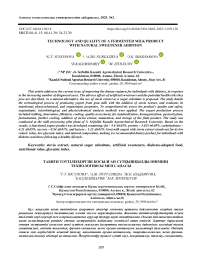Technology and quality of a fermented milk product with natural sweetener addition
Автор: Yussupova G.T., Nurgazieva A.Zh., Shadyarova J.K., Kalemshariv B., Iztileuov M.
Журнал: Вестник Алматинского технологического университета @vestnik-atu
Рубрика: Технология пищевой и перерабатывающей промышленности
Статья в выпуске: 3 (149), 2025 года.
Бесплатный доступ
This article addresses the current issue of improving the dietary regimen for individuals with diabetes, in response to the increasing number of diagnosed cases. The adverse effects of artificial sweeteners and the potential health risks they pose are described. As a natural alternative, the use of stevia extract as a sugar substitute is proposed. The study details the technological process of producing yogurt from goat milk with the addition of stevia extract, and evaluates its nutritional, physicochemical, and organoleptic properties. To comprehensively assess the product's quality and safety, organoleptic, microbiological, and physicochemical analysis methods were applied. The yogurt production process included milking, deaeration, filtration, cooling, quality assessment, fat standardization, homogenization, pasteurization, fermentation, further cooling, addition of stevia extract, maturation, and storage of the final product. The study was conducted at the milk processing pilot plant of S. Seifullin Kazakh Agrotechnical Research University. Based on the results, a functional yogurt product was developed containing: fat – 5.8 ±0.05%, protein – 5.425 ±0.05%, carbohydrates – 4.21 ±0.05%, sucrose – 0.54 ±0.01%, and lactose – 1.23 ±0.01%. Goat milk yogurt with stevia extract stands out for its low caloric value, low glycemic index, and natural composition, making it a recommended dietary product for individuals with diabetes and those following a healthy lifestyle.
Stevia extract, natural sugar substitute, artificial sweeteners, diabetes-adapted food, nutritional value, glycemic index
Короткий адрес: https://sciup.org/140312197
IDR: 140312197 | УДК: 637.146:641.563.8 | DOI: 10.48184/2304-568X-2025-3-109-120
Текст научной статьи Technology and quality of a fermented milk product with natural sweetener addition
UDC 637.146:641.563.8
In the Republic of Kazakhstan, a decline in the consumption of white sugar and sugar-containing products was observed in 2024 (Figure 1). According to official statistics, the average per capita sugar consumption in 2024 amounted to 10.3 kg, which is 1.3% less compared to 2023. A decrease was also recorded in the consumption of sugar-containing products: refined sugar – 113 g (down by 27.6%), jams and preserves – 547 g (down by 27.4%), candies and chocolate – 687 g (down by 11.2%), honey — 293 g (down by 0.3%), and other sweet products – 3.7 kg (down by 2.8%) [1–2].
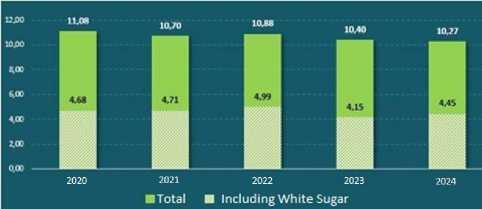
Figure 1. Consumption indicators of white sugar, jam, honey, candies, chocolate, and other sweets in 2020-2024 (kg).
As shown in Figure 1, between 2020 and 2024, the per capita consumption of refined sugar in Kazakhstan decreased from 11.08 kg to 10.27 kg. According to regional data (Figure 1), in 2024, the highest consumption of sugar and sugar-containing products was recorded in Almaty city (average 12.46 kg) and Turkestan region (11.28 kg) [3-4].

Figure 2. Sugar and sugar-containing product consumption indicators across regions of the Republic of Kazakhstan in 2024 (kg)
However, despite the decline in these indicators, the number of people with diabetes in Kazakhstan has sharply increased over the past 15 years, rising 3.5 times by 2024 (Figure 3).

Figure 3. Comparative statistics of individuals with type 1 and type 2 diabetes in Kazakhstan in 2009 and 2024.
According to data from the Ministry of Health of the Republic of Kazakhstan, over the past 15 years, the number of people diagnosed with diabetes has increased by 3.5 times. As of early 2024, 382,000 individuals were registered for dispensary observation, including 30,000 with type 1 diabetes and 352,000 with type 2 diabetes [5].
According to the World Health Organization, diabetes, dental diseases, cardiovascular diseases, and cancer are currently among the most common illnesses. One of the main causes of these diseases is disruptions in the digestive system, hypoglycemia, and metabolic disorders. Excessive consumption of white sugar has been identified as a major contributing factor to these conditions. In addition, modern artificial sweeteners such as aspartame, saccharin, and cyclamate have also been shown to negatively affect the human body. Although their primary advantage over white sugar is low calorie content, long-term use may lead to obesity, diabetes, and other health issues [6].
Stevia ( Stevia rebaudiana ) is a plant widely used as a natural sweetener. Native to South and Central America, it has long been used by local populations as a natural sugar substitute and for medicinal purposes. The main feature of stevia is its content of sweet compounds called steviol glycosides, which provide a sweet taste without adding calories to the body. This makes stevia an ideal natural sweetener for individuals who follow a healthy lifestyle and wish to limit sugar and calorie intake.
Stevia is available in various forms, including dried leaves, powder, and liquid. It can be used as a sugar substitute in beverages, desserts, and other foods. Given its beneficial properties, stevia can be incorporated into a balanced diet. However, it is important to consider individual health conditions when using stevia [7-10].
Stevia contains no calories, and its sweetness is 200–350 times greater than that of white sugar. This makes it a safe alternative for people with diabetes. Stevia also contains antioxidants such as kaempferol, flavonoids, and tannins, which have been found to reduce the risk of pancreatic cancer by up to 20%. Additionally, stevia helps lower blood pressure by dilating blood vessels and promoting the excretion of sodium from the body.
The widespread use of sucrose in dairy product manufacturing can lead to various health problems, including diabetes, obesity, and tooth decay. As a result, there has been growing demand for natural sugar substitutes, including stevia extract. Since stevia contains no carbohydrates, it serves as an excellent alternative for people with diabetes. Furthermore, the biologically active compounds found in stevia (such as carbohydrates, vitamins, minerals, and antioxidants) make it a beneficial additive for promoting overall health [11-13].
Materials and research methods
The study was conducted to determine the qualitative characteristics and consumer value of the product “Goat milk yogurt with stevia extract” two types of data sources were used during the research: primary and secondary data.
Primary data included information obtained directly from consumers and producers, as well as results from experimental research and product testing. These data were collected through surveys, interviews, observation methods, and pilot production. They allowed for the evaluation of key aspects such as product quality, taste properties, pricing, and consumer perception.
Secondary data were gathered from existing sources, including scientific articles, market research, official statistical reports, consultancy studies, and consumer reviews from online platforms. These sources helped assess current trends in yogurt production, consumer demand, and market conditions.
To evaluate the quality and nutritional value of the finished product, the following methods were used:
-
- Microbiological indicators – tests were carried out according to GOST 32901-2014 to ensure the sanitary and hygienic safety of the product.
-
- Organoleptic indicators – color, taste, smell, and texture were assessed according to the Kazakhstan standard ST RK 1732-2007.
The evaluation involved academic staff of the Departments of “Standardization, Metrology and Certification” and “Food and Processing Technologies,” as well as technologists and master’s students. In total, about 30 participants aged between 20 and 64 years took part in the tasting. The product was assessed on a 5-point scale based on taste, smell, color, consistency, and appearance.
-
- Protein content – determined according to GOST 25179-2014.
-
- Fat content – measured using the method outlined in GOST 5867-90.
Carbohydrate content – determined using the permanganatometric method in accordance with GOST R 54760-2011.
-
- Energy value – caloric content and nutritional value were calculated using the methodology developed by I.M. Skurikhin.
Goat milk from the Saanen breed was used for yogurt production due to its high protein and fat content.
The products were tested in the research laboratory "Quality and Safety Assessment of Food Products" at Almaty Technological University and in the "Agricultural Biotechnology Scientific Research Platform" of the Scientific Center of the S. Seifullin Kazakh Agrotechnical Research University.
Results and discussion
Three natural, plant-based sweeteners are considered as alternatives to sugar in yogurt: stevia ( Stevia rebaudiana ), erythritol, and monk fruit (Luo Han Guo). Each sweetener has unique properties and advantages compared to traditional sugar.
Stevia, derived from the leaves of the Stevia rebaudiana plant, is known for its high sweetness (50300 times sweeter than sugar) and zero calories. Its main active components are steviosides and rebaudiosides. Since stevia does not affect blood glucose levels, it is highly suitable for people with diabetes and those monitoring their body weight. In addition, it contains antioxidants that have anti-inflammatory effects and support the cardiovascular system.
In yogurt, stevia provides a pleasant sweet taste without increasing the caloric load, making it widely applicable in functional food production.
Erythritol is a sugar alcohol naturally found in fruits. It is about 70% as sweet as sugar but has very low caloric content-only 0.24 kcal/g-meaning it has virtually no energy value. Erythritol does not affect blood sugar levels, does not cause tooth decay, and is relatively well tolerated by the digestive system. Around 90% of it is absorbed in the small intestine and excreted through the kidneys, so side effects like diarrhea or bloating occur only when consumed in excessive amounts.
It is also suitable for vegetarians and those following gluten-free diets. Additionally, erythritol inhibits the growth of pathogenic bacteria in the oral cavity, which is why it is commonly used in toothpastes and chewing gums. Studies have shown it helps prevent cavities, reduces plaque formation, and has antioxidant effects.
Monk fruit, a natural sweetener derived from the Buddha fruit that grows in the tropical regions of Asia, is 150-200 times sweeter than sugar due to active compounds known as mogrosides. These compounds do not impact blood sugar levels, do not stimulate insulin production, and may help accelerate fat breakdown.
In traditional Chinese medicine, monk fruit has been used to relieve sore throats and reduce phlegm. It contains vitamin C, antioxidants, as well as vitamins A, B, E, and K, and important micronutrients such as calcium, iron, and magnesium. Its antioxidant properties may help prevent cancer, fight infections, and reduce the harmful effects of alcohol and tobacco. A comparative overview of the sweeteners is presented in Table 1.
Table 1. Comparative Characteristics of Sweeteners
|
Parameter |
Stevia |
Erythritol |
Monk Fruit |
|
Sweetness Level |
200-300 times sweeter than sugar |
60-80% as sweet as sugar |
150-200 times sweeter than sugar |
|
Caloric Content (in yogurt, kcal/100g) |
45 |
- |
- |
|
Glycemic Index (GI) |
0-5 |
0 |
0 |
|
Carbohydrates (g/100g) |
4.21 |
- |
- |
|
Antimicrobial Properties |
Present |
Present |
Present |
|
Probiotic Effect |
None |
None |
Present |
|
Intestinal Fermentation |
None |
None |
None |
|
Solubility (g/100 ml) |
50-100 |
40-60 |
50-70 |
|
Melting Point |
Not specified |
121°C |
Not specified |
|
pH Level |
5.0-7.0 |
4.5–7.0 |
4.0-6.0 |
|
Shelf Life (days) |
21 |
- |
- |
|
Probiotics ( L. acidophilus ) |
1.2 x 108 CFU g |
- |
- |
|
Organoleptic Taste Rating (5-point scale) |
5.0 |
- |
- |
In this study, stevia was selected as the most effective natural alternative for adding to yogurt among various sweeteners. There are several reasons for its choice:
Firstly, stevia is a very low-calorie sweetener, which significantly reduces the total calorie content of yogurt (45 kcal/100 g), which is very important for people struggling with overweight and obesity. Compared to sugar, the use of stevia reduces the calorie content of yogurt by approximately three times.
Secondly, stevia has a very low glycemic index (0–5), which makes it a safe product for people with diabetes. Unlike yogurt with added sugar or honey, stevia does not cause a sharp increase in blood sugar levels and does not require insulin production.
Thirdly, it has been scientifically proven that stevia has antimicrobial properties. This indicates that it helps to extend the shelf life of food products. The research results showed that yogurt made with stevia lasted up to 21 days, which is the longest shelf life compared to other sweeteners.
Fourthly, according to organoleptic evaluation, yogurt made with stevia received high marks for taste, smell, color, and consistency. Especially the taste was rated 5 points, which indicates positive acceptance of the product by consumers.
Fifthly, stevia has high solubility (50–100 g/100 ml) and maintains stability at a neutral pH level (5.0– 7.0), making it convenient for use in food technology.
Also, stevia does not negatively affect probiotics. The study showed that yogurt made with stevia retained a sufficient amount of Lactobacillus acidophilus bacteria (1.2 × 10⁸ CFU/g), which ensures the retention of the probiotic value of the product and its health benefits.
Now, let’s compare stevia with other sweeteners such as sugar, fructose, and honey, which are commonly used in daily life. Typically, sugar is added to yogurts because it enhances the flavor and is familiar to consumers. However, the use of sugar significantly increases the calorie content of yogurt and raises its glycemic index.
Fructose is often used as a low-calorie alternative to sugar. Although it has a low glycemic index (GI), excessive consumption of fructose can lead to metabolic disorders. Honey, being a natural product, has antibacterial and antioxidant properties, but it contains a lot of carbohydrates, and its GI is high.
In this study, four yogurt samples based on goat’s milk were developed, each with a different sweetener added:
-
- Yogurt with stevia extract;
-
- Yogurt with sugar;
-
- Yogurt with fructose;
-
- Yogurt with honey.
The nutritional characteristics of each sample are presented in Table 2.
Table 2. Nutritional value of goat milk yogurts (per 100 g of product)
|
Indicator |
Stevia |
Sugar |
Fructose |
Honey |
|
Calories (kcal) |
45 |
120 |
110 |
130 |
|
Proteins (g) |
5.4 |
5.4 |
5.4 |
5.4 |
|
Fats (g) |
5.8 |
5.8 |
5.8 |
5.8 |
|
Carbohydrates (g) |
4.21 |
10.35 |
9 |
15.0 |
|
Vitamin A (mg) |
0.15 |
0.15 |
0.15 |
0.15 |
|
Calcium (mg) |
120 |
120 |
120 |
120 |
As seen, the yogurt with stevia extract contains significantly fewer calories compared to other yogurts. The table also shows that the amounts of proteins and fats are the same across all samples, as they are all based on goat milk. However, the amount of carbohydrates varies depending on the sweetener used. Stevia, as a natural sweetener, contains virtually no carbohydrates, which significantly reduces the overall calorie content of the product. Additionally, stevia has a glycemic index close to zero, making it a safe alternative for people with diabetes, as it does not affect blood glucose levels.
In the course of the study, we compared the technological processes of producing yogurt with added regular white sugar and yogurt with added stevia extract. Although the production process for yogurt with stevia extract is more complex compared to yogurt with white sugar, it is more beneficial for consumers (Figures 6,7).
To prepare yogurt from goat's milk with stevia extract, fresh milk is filtered, normalized to a temperature of t=40±2°C, undergoes a deaeration process, and is then cooled to t=40±2°C. The quality of the whole milk is assessed (fat content 4.90%, protein 2.90%, SOMO 8.41, density 28.40, acidity T=14-20) and accepted. The milk is heated to t=40°C. The homogenization process is carried out at t=60°-65°C with a pressure of 15-17 mPa. Pasteurization is performed at t=85±2°C for 5 seconds, then cooled to t=40±2°C, after which cultures such as Bulgaricus and Streptococcus thermophilus are added, and the mixture is stirred for 10-15 minutes. Fermentation is carried out at t=40±2°C until pH reaches 80-90°T. The starter is cooled to t=21°-22°C (see Figure 4).
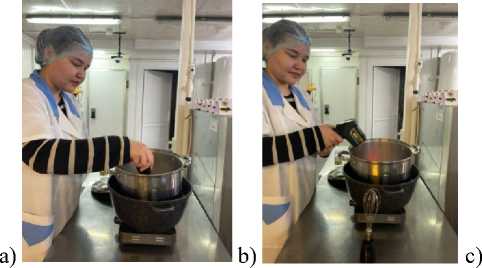
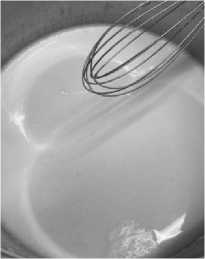
-
a) Lactobacillus bulgaricus and Streptococcus thermophilus are added to the prepared milk and mixed for 10 minutes.
-
b) Fermentation is carried out at t = 38°–40°C until the pH reaches 4.6-4.55.
-
c) The final yogurt with starter culture is ready.
Figure 4. The process of making yogurt from goat's milk
In addition, the stevia extract is prepared (see Figure 5). Method of preparing stevia extract:
-
- Dried stevia herb is soaked in water at room temperature;
-
- It is held at t=20±2°C for 2 hours;
-
- Pasteurized at t=85±2°C;
-
- Cooled to t=20±1°C;
-
- Packaged and stored at t=4±2°C [14,15].
d)
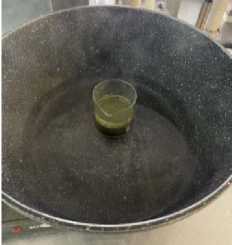
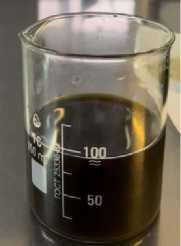
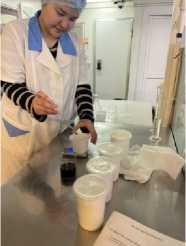
-
d) Dried stevia leaves are mixed with water at room temperature and placed in a water bath, f) The mixture is infused and pasteurized in the water bath at a temperature of t=80±1°C, g) The prepared stevia extract is added to the finished yogurt.
Figure 5. Process of preparing stevia extract and adding it to the finished yogurt.
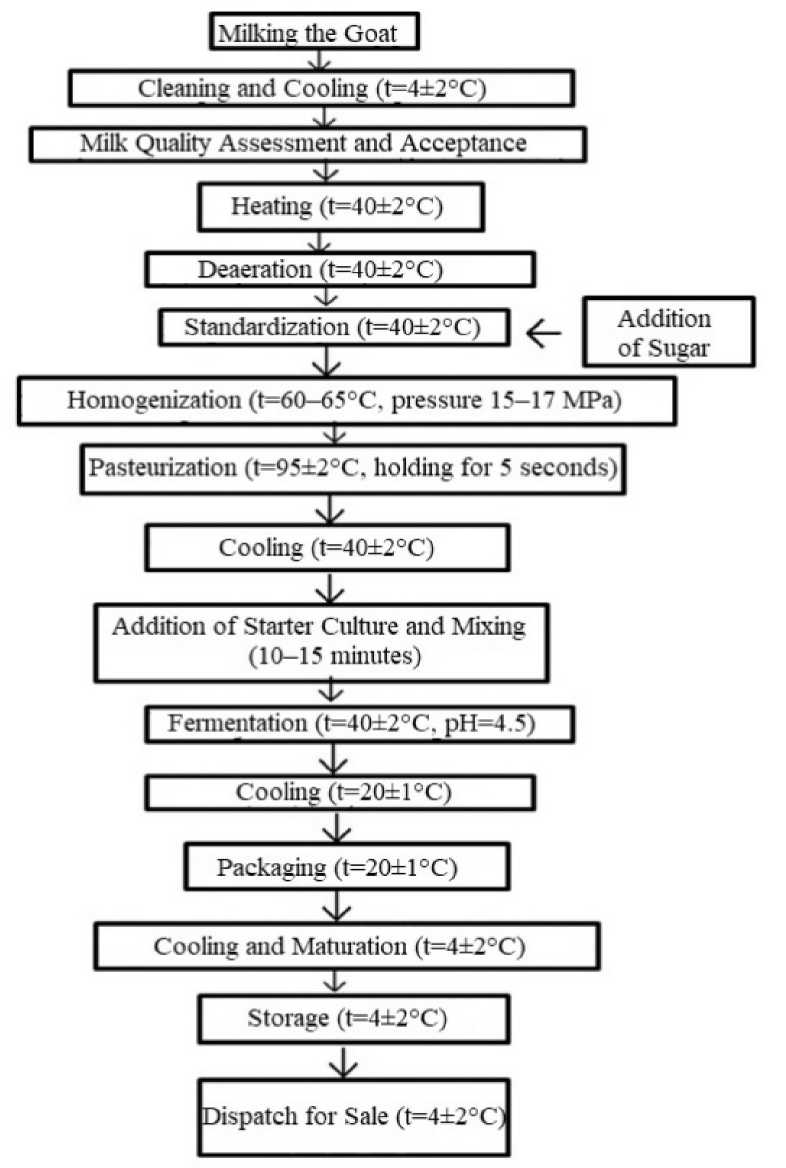
Figure 6. Production technology of goat milk yogurt with added white sugar
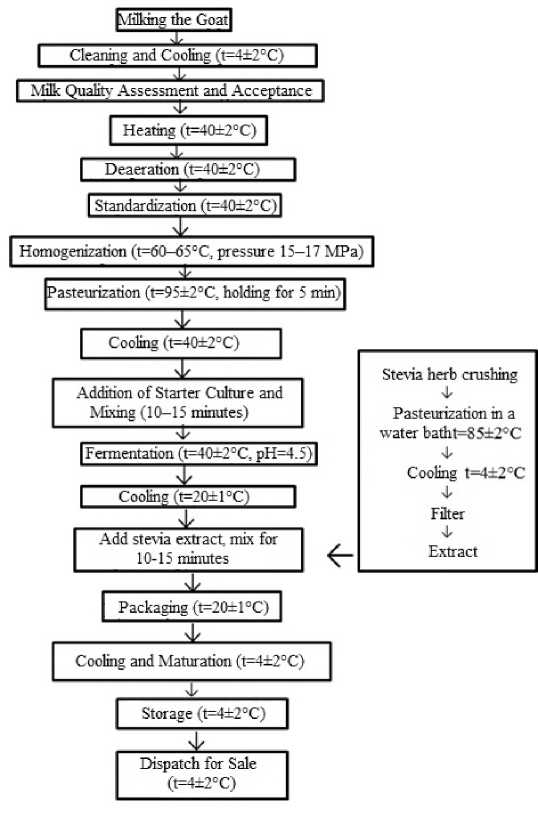
Figure 7. Production technology of goat milk yogurt with added stevia extract
The comparative physicochemical indicators of goat milk yogurt with added white sugar and goat milk yogurt with added stevia extract are shown in Figure 8.
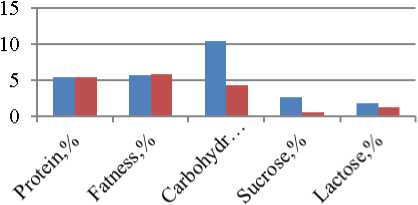
■ Goat's milk yogurt with white sugar
■ Goat's milk yogurt with stevia extract
Figure 8. Comparative quality indicators of goat milk yogurt with added sugar and goat milk yogurt with added stevia extract
According to the study results, the mass fraction of carbohydrates in the yogurt with added white sugar was 5.6%, while in the yogurt with added stevia extract, it was 4.21%. The sucrose content in the white sugar version was 2.59%, while in the product with stevia extract, it was 0.54%. The lactose content was 1.75% and 1.23%, respectively.
These figures indicate that goat milk yogurt with added stevia extract has a significantly lower carbohydrate load and is more suitable for consumers who need to limit their sugar intake. Therefore, the product with stevia is a functionally effective alternative that meets the requirements for food safety and healthy nutrition.
The indicators of the number of viable microorganisms in goat milk yogurt with added stevia extract are shown in Table 3.
Table 3. Indicators of the number of viable microorganisms in goat milk yogurt with added stevia extract
|
Name of milk processing product |
Lactic acid microorganisms, probiotic microorganisms, yeast |
|
|
Norm of TR 033/2013 |
Goat's milk yogurt with stevia extract |
|
|
Yogurt |
Yeast at the end of the shelf life: for ayran, kefir - not less than 1x104 CFU/cm³ (g), for koumiss -not less than 1x105 CFU/cm³ (g) |
Not less than 1x104 KTB/cm³ (g). |
In accordance with the technical regulation of the Customs Union – TR TS 033/2013 "On Food Safety," the number of viable microorganisms in yogurt, kefir, and ayran must be at least 1×10⁴ CFU/cm³ (g), while in kumis, it must be at least 1×10⁵ CFU/cm³ (g).
As a result of the study, the number of colonyforming units (CFU) in goat milk yogurt with added stevia extract was determined to be 1×10⁴ CFU/cm³ (g). This indicator fully complies with the requirements of TR TS 033/2013, confirming the product's microbiological safety and compliance with the standards for viable yeast microorganisms.
When stevia extract is added, the yogurt consistency becomes more viscous, and it is characterized by a uniform structure.
Taste and smell – The product has a moderate sweetness with a typical sour milk product flavor. While a slight distinctive scent remains, the overall natural milk aroma prevails.
Color – It has a rich creamy shade. The pale green color of the stevia extract, evenly distributed throughout the mass, is acceptable (Table 4).
Table 4. Organoleptic properties of goat milk yogurt with added stevia extract
|
Indicator |
Requirements |
Research results |
|
Consistency |
Homogeneous medium viscosity |
The consistency becomes thicker when stevia extract is added. |
|
Taste and smell |
Characteristic of a pasteurized fermented milk product.Smell characteristic of a lactic acid product |
When stevia extract is added, it is characterized by a medium sweetness and lactic acid. It has a slight peculiar smell. |
|
Color |
Milky-creamy, evenly |
Rich creamy color, light green color of stevia extract evenly distributed throughout the mass is allowed |
A tasting study of goat milk yogurt with added stevia extract and yogurt with added sugar was conducted at the Department of "Standardization, metrology, and certification" of the . Kazakh
Agrotechnical University named after S. Seifullin. The study involved a comparative analysis of the products' appearance, color, consistency, taste, and smell (Figure 9).
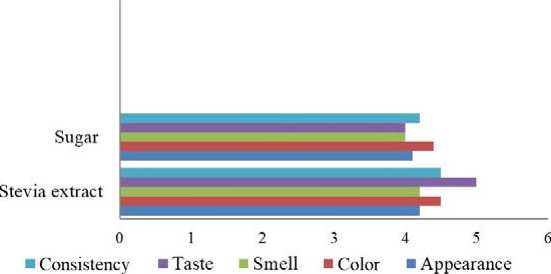
Figure 9. Comparative tasting evaluation of goat milk yogurts with added sugar and goat milk yogurts with added stevia extract based on average score.
The conducted sensory tests revealed several advantages in the organoleptic characteristics of goat milk yogurt with the addition of stevia extract.
In particular, the appearance of the yogurt with stevia extract received an average score of 4.2, which is 0.1 points higher than the yogurt with sugar (4.1 points). Although both products were rated similarly for color and aroma, the samples with stevia received slightly higher scores due to the harmony of their natural shade and milk aroma.
Regarding taste, the experts gave the yogurt with stevia extract 5.0 points, while the yogurt with sugar received 4.0 points. This confirms that the product with stevia extract has a pleasant, mild taste and moderate sweetness.
Differences in consistency were also observed: although stevia extract does not have the thickening properties of sugar, the yogurt's light structure and ease of consumption were positively evaluated by the experts, with the stevia yogurt receiving 4.5 points. On the other hand, the consistency of the yogurt with sugar was rated at 4.2 points.
It is worth noting that, although the taste and structure of yogurt with sugar are familiar to consumers, the natural and unique characteristics of the stevia-based product may become highly sought after in the future as it adapts to consumer culture.
Conclusions
The study comprehensively evaluated the effect of various sweeteners—stevia, sugar, fructose, and honey-on the nutritional, microbiological, physicochemical, and organoleptic properties of goat milk yogurts. All components of the yogurts and the obtained results fully comply with the requirements of the Customs Union Technical Regulation KО TR
033/2013 "On the Safety of Milk and Dairy Products" and the norms of the standards. These indicators confirm the high quality and safety of the studied products.
According to the results of the study, stevia was recognized as one of the most effective natural sweeteners. It significantly reduces the calorie content of yogurt (by 45 kcal) and minimizes its glycemic index (0– 5), which is especially important for consumers with diabetes and those monitoring their body weight. Furthermore, it was found that stevia helps extend the shelf life of yogurt and exhibits antimicrobial properties.
Based on the results of organoleptic evaluation, the yogurt with stevia also received high scores for taste, color, and consistency.
Thus, the use of stevia in the production of goat milk yogurt is a safe and effective solution that not only enhances the nutritional and functional value of the product but also contributes to the protection of consumer health.
Patent No. 10204 for the utility model "Goat Milk Yogurt with Stevia Extract" has been granted for this product by the National Institute of Intellectual Property.

